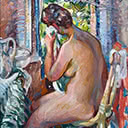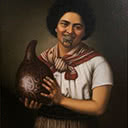Girl with Gourd
83 x 65.4 cm
est. $220,000 - 320,000
PROVENANCE Private Collection, Auckland
EXHIBITED The Maori Portraits: Gottfried Lindauer's New Zealand Auckland Art Gallery 22 October 2016 - 19 February 2017
The Auckland Art Gallery label that accompanied this work in the exhibition The Maori Portraits: Gottfried Lindauer's New Zealand read: The subject of this version of 'girl with gourd' is Mere Nireaha, daughter of chief Tamaki Nireaha from Rangitane and Ngati Kahungunu ki Wairarapa. Nireaha has been transformed from a photograph showing her holding a gourd, dressed in a waist garment. The subject is variously referred to as 'laughing girl' perhaps for breaking her smile.
This exceptionally fine work by Gottfried Lindauer is an engaging portrait of a young Maori woman holding an intricately carved gourd or hue. In summer the young fruit of the hue was gathered, baked and eaten. Larger hue were hollowed out and used as water vessels, food containers and musical instruments. The smiling subject of Lindauer's portrait is attired in both European and traditional garments, her facial moko kaue being a sign of her mana. Gottfried Lindauer, along with C F Goldie is the best-known painter of Maori subjects from the late nineteenth-early twentieth centuries. Born in Pilsen, Bohemia, then part of the Austro-Hungarian Empire he trained professionally at the Academy of Fine Arts in Vienna, migrating to New Zealand in 1874.
Lindauer's first portraits of Maori were painted in Nelson. A move to Auckland in the mid 1870s proved crucial. There he met businessman, Henry Partridge (1848-1931), who over the next 30 years commissioned from Lindauer numerous portraits of eminent Maori, as well as large-scale depictions of traditional Maori life. The aim of the project was to create a pictorial history of Maori at a time when it was widely, though mistakenly, believed that Maori were dying out, either literally or as a distinct cultural group.
Lindauer travelled extensively throughout New Zealand living in a variety of locations besides Nelson and Auckland, notably Christchurch, Napier where he was closely associated with the photographer Samuel Carnell (1832-1920), also a well-known portraitist of Maori, and finally, from 1889, Woodville. Lindauer retained his European and Czech connections.
In 1886 he attended the Colonial and Indian Exhibition in London, where twelve of his Maori portraits were exhibited. The commissioner of the New Zealand pavilion was Walter Buller (1838- 1906), a lawyer who represented both Maori and European clients, and an important patron of the artist. Lindauer and his family lived in Europe, mainly Germany from 1900 to 1902 and again from 1911 to 1914, with short visits to Bohemia. During this time several of his Maori portraits were placed in public and private collections there.
Besides Lindauer's portraits of eminent Maori, he produced many of little-known or ordinary Maori people, most of whom wear European dress, as would have been the case in their daily life. Most, but not all, of these were probably commissioned by the sitters or their families. Henry Partridge opened a gallery in Queen Street, Auckland, in 1901, which initially featured 40 of Lindauer's Maori portraits. By the time Partridge gifted his Lindauer collection to the Auckland Art Gallery in 1915, there were 62 portraits. The historian, James Cowan (1870-1943) wrote a descriptive catalogue of the collection describing it as unrivalled in the world.
Lindauer's contribution and legacy to the history of art in New Zealand is considerable and highly valued.





